Large Government IT Projects = High Risk
Government organizations struggle to successfully implement Government Resource Planning (GRP) systems. This includes custom-developed Financial Management Information Systems (FMIS), the customization of Enterprise Resource Planning (ERP), and other commercial enterprise software applications. Implementations of software originally developed for the private sector are particularly challenged. There seems to be higher risk for information technology projects in the public sector compared to the private sector.
No one seems to be doing anything about it.
FreeBalance GRP Success Blueprint
We’ve learned a thing or two about success factors after 35 years of exclusive government GRP experience. And, successful implementations in very trying circumstances. For one thing, traditional IT project “best practices” rarely are. Many orthodox approaches represent poor practices. And, much of the advice provided by experts lack useful depth and coverage. (A web search for “ERP Success Factors” generates a lot of useless information.)
That’s why we’ve developed the FreeBalance GRP Success Blueprint.
This Blueprint generates scorecards to visualize risk mitigation opportunities.
Jump to the end of the blog post if you want to beta test the Blueprint.
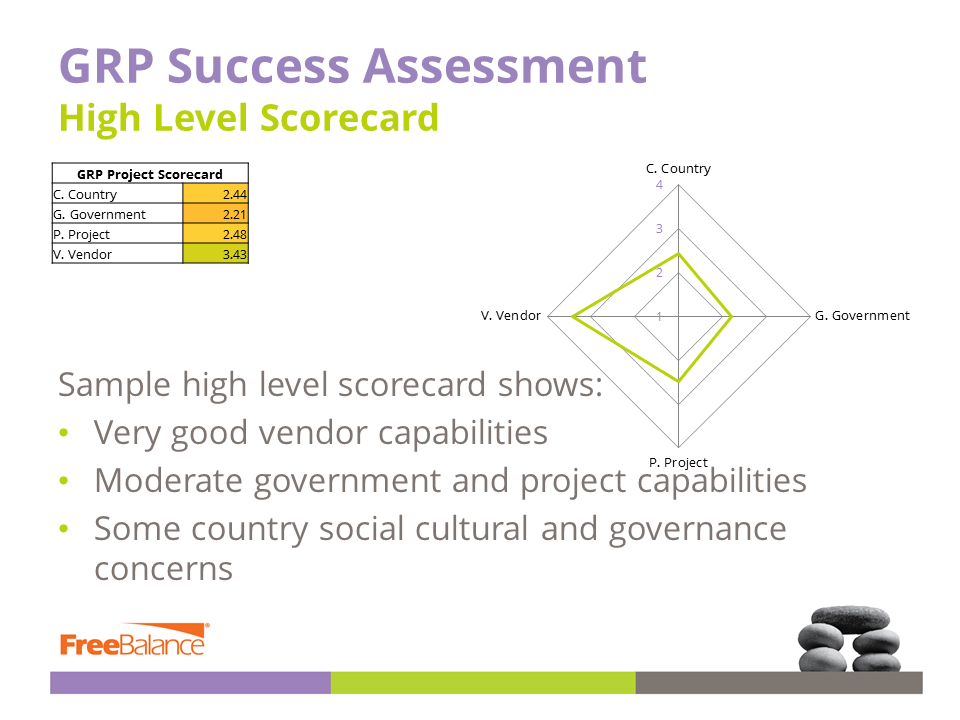
This “blueprint” enables FreeBalance and governments to improve success factors across four contextual pillars:
- Country enabling environment categories:
- Political enabling environment
- Human capacity
- Technology readiness
- Social-cultural enabling environment
- Government enabling environment categories:
- Leadership buy-in
- Positive incentives
- Project capacity
- Organizational change readiness
- Project enabling environment categories:
- Project practices
- Public Financial Management (PFM) practices
- Requirements alignment
- Customization avoidance
- Vendor capabilities categories:
- Vendor capacity
- Vendor technology
- Vendor governance
- Vendor commitment
Each category has between 4 and 10 factors. The draft GRP Success Blueprint includes 100 factors in total. Each factor is evaluated on a scale of 1 to 4. Most factor evaluations are based on text descriptions requiring critical assessment capabilities. Most of the country context is found via third party assessments like the Worldwide Governance Indicators.
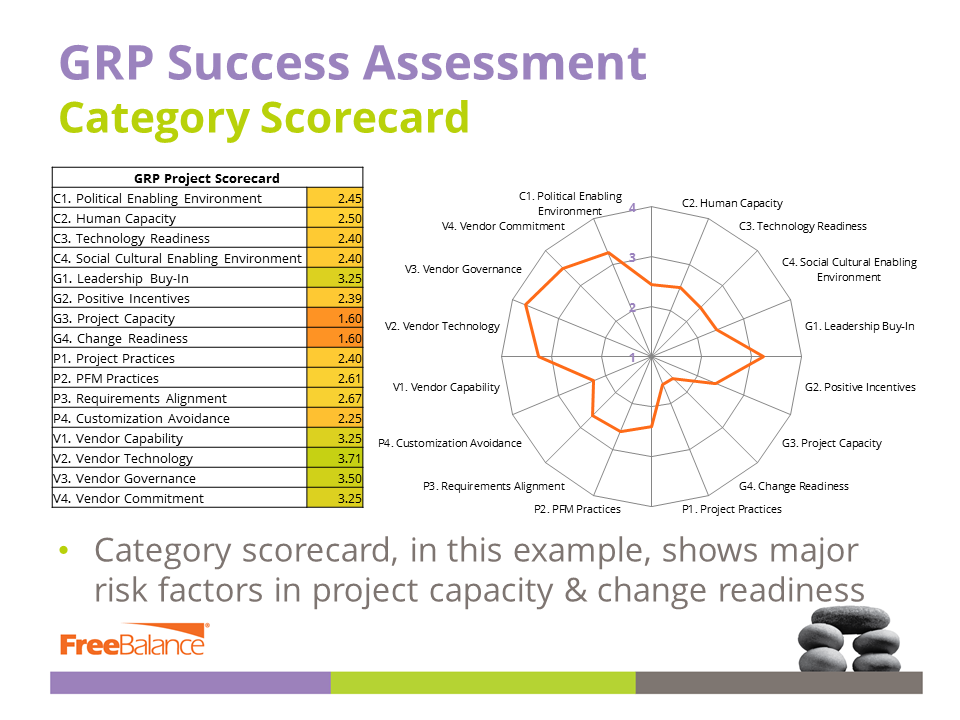
Risk and Success Diagnostics
The FreeBalance GRP Success Blueprint uses standard spreadsheet technology. The Blueprint, as diagnostics, has the following characteristics:
- Ability to use regardless of technology or vendor selection (could be applied to non-GRP projects, using a subset of factors)
- Primarily use of ordinal values where gaps between ratings are not necessarily equal
- Concept of equality across categories that could be misleading (use of a spreadsheet means ability to weight characteristics)
- Support across the implementation lifecycle (including as a planning tool for governments contemplating PFM reform)
- Is not about “best practices”, rather acts as warning system
- Increased accuracy of ratings as projects mature
- Some factors cannot change, therefore mitigation strategies for improving other factors become more critical
- Rejects the notion that technology or vendors play positive or negative roles in implementation success
- Focus on elements relevant to the government context, so may not be fully applicable by private sector organizations
Implementation Lifecycle
The Blueprint is designed for the entire implementation lifecycle:
- Planning
- Governments can use the Blueprint to plan acquisition requirements, and project methodologies
- External indicators are collected
- FreeBalance leverages Blueprint for existing government customers, and prospective customers
- Proposal
- FreeBalance creates risk registers after receiving government proposals that provides input to the Blueprint
- Proposals formalize vendor requirements, and project methodologies that can be assessed
- Organizational change management, agile project methodologies, and capacity building are critical factors in GRP projects, much more important than in the private sector
- Project
- The Blueprint enables risk mitigation and monitoring strategies set during project kick-off
- Risk monitoring drives stakeholder progress communication
- Success factors change during projects, demonstrating the importance of scorecards
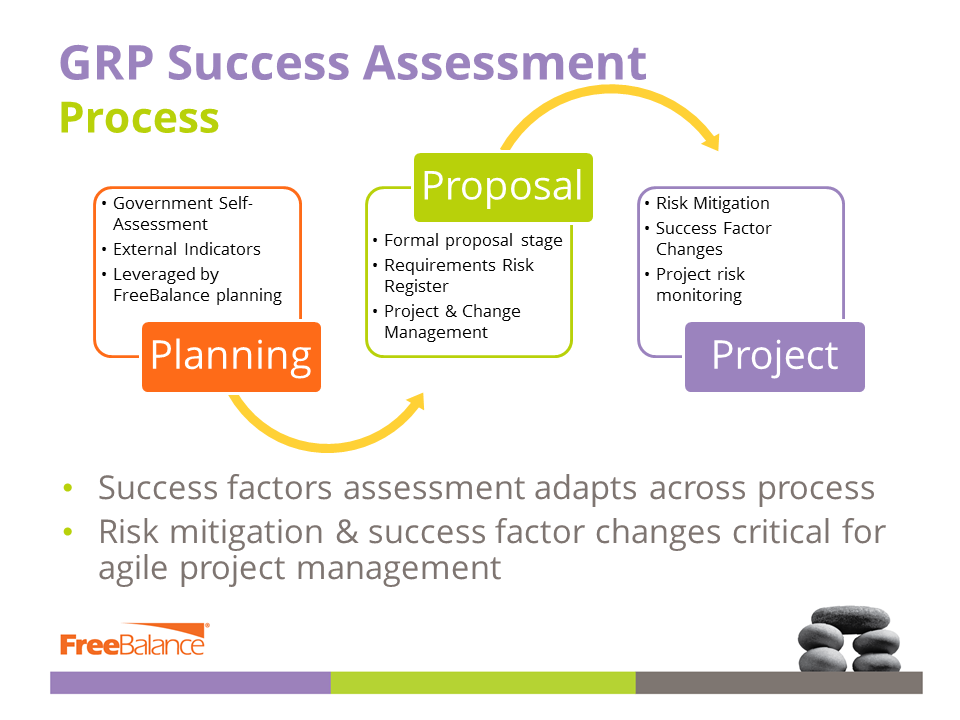
FreeBalance Repeatable Processes
The FreeBalance Strategy and Innovation group has developed repeatable implementation processes. We continue to add processes to improve success repeatability. Adapted for the government domain, this customer-centric approach aligns with our ISO9001:2015 quality management system. Current process definitions include:
- Blueprints – covering GRP success, configuration, and good practice targets
- Canvases – covering country context, governance diagnostics, government blockchain adoption, governance gaps, information technology diagnostics, risk registers, organizational change management, and talent management
- Boards – covering agile processes, design thinking, brainstorming, software change management, and project status
- Templates – covering storyboards, specifications, return on investment, business cases, policies and procedures
Process tables articulate how blueprints, canvases, boards, and templates operate. Processes integrate as input and output “work products”.
Of course, there is a template for articulating processes.
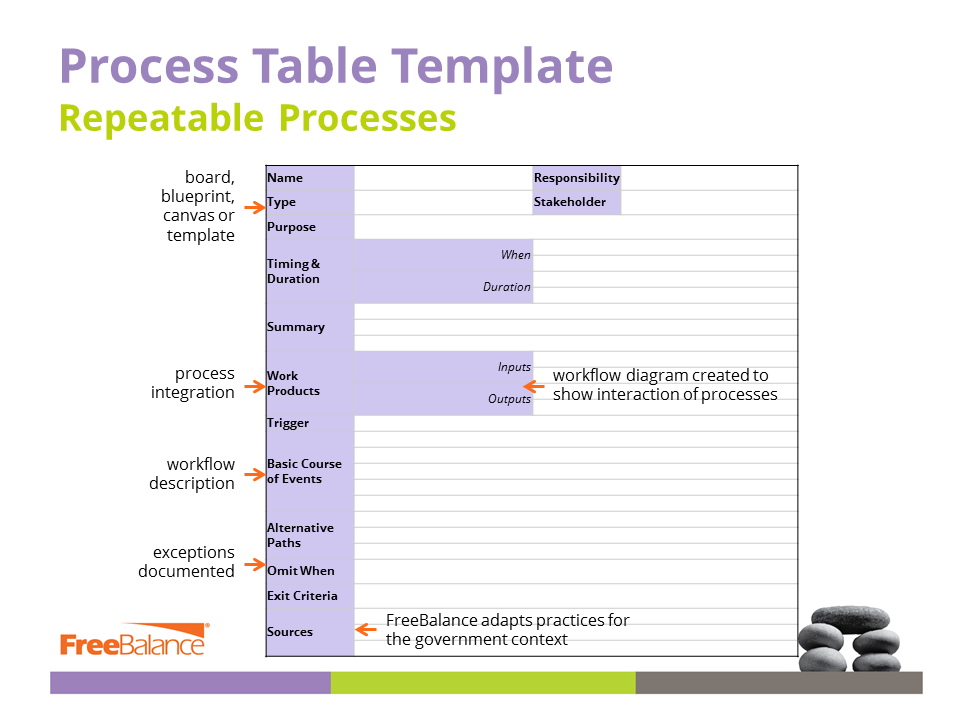
FreeBalance leverages articulated and repeatable processes for internal purposes.
Project Management Conventional Wisdom = High Risk?
Government organizations opt for rigid, highly documented project management techniques. This often leads to spectacular failure. And, often leads to conclusions that processes were not sufficiently rigid and documented. That’s the project paradox – rigid “waterfall” processes are risky. Modern agile process, in use by major web companies, reduce costs while better meeting user expectations. Much of the documentation required by government processes are ceremonial in nature. Provides little or no value. Creates delays. Increases costs. Increases change resistance. Conventional wisdom steeped in legacy thinking.
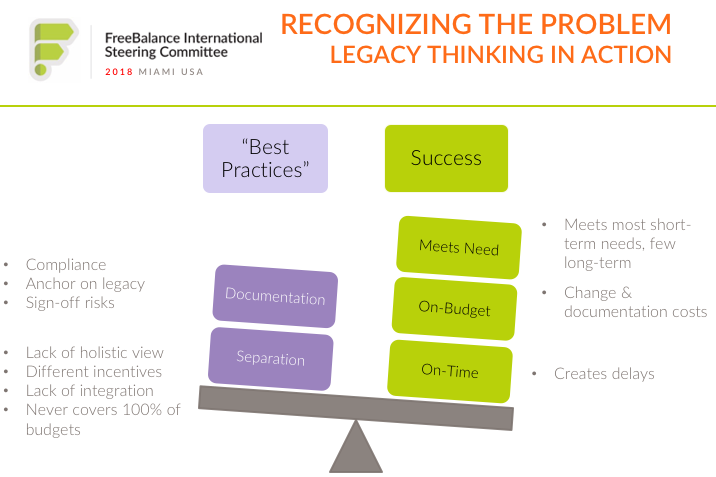
Waterfall project management assumes high predictability. Some GRP and government IT projects have relatively good predictability. Not all waterfall GRP projects fail. The Agile or Waterfall GRP Checklist enhances the GRP Success Blueprint with more detailed risk analysis. 26 project elements are weighted by impact to provide guidance.
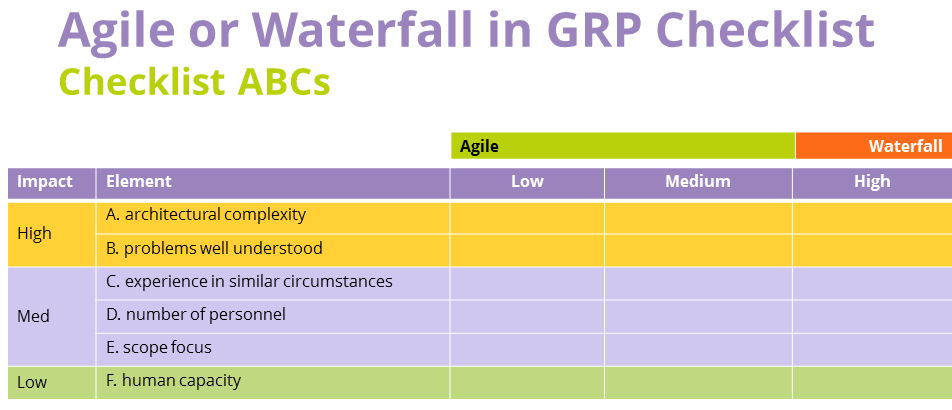
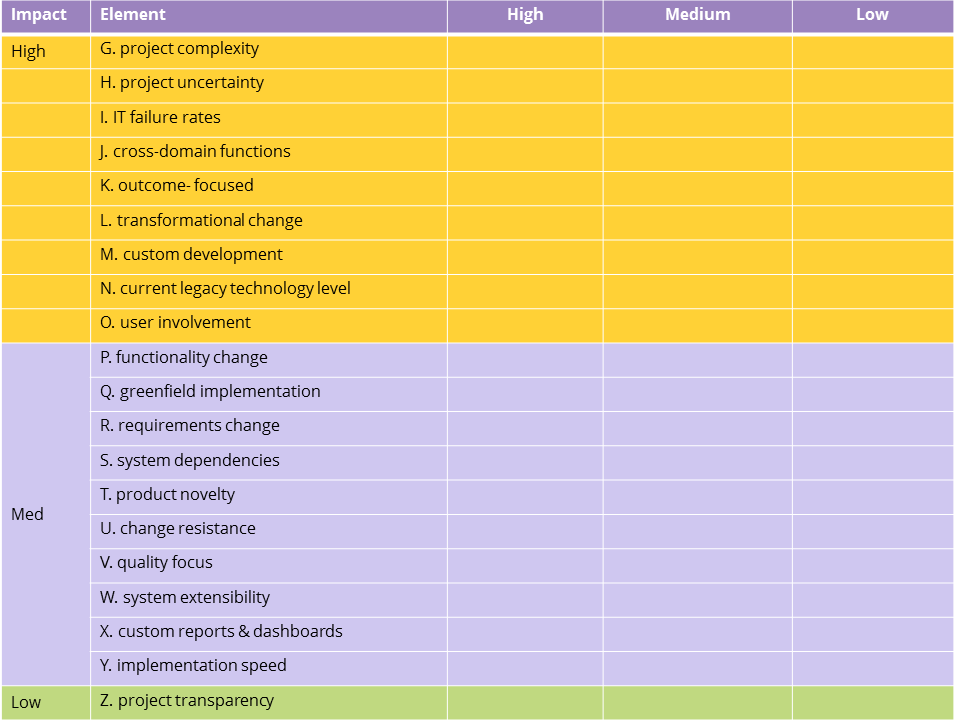
Enterprise Software Conventional Wisdom = High Risk?
Governments often seek to acquire Enterprise Resource Planning (ERP) software. When is ERP software, written for the private sector, appropriate in government? As a GRP vendor, we believe that ERP is rarely appropriate for core government financial management. Many observers suggest that FreeBalance is an ERP vendor by providing comprehensive systems of record for government. Our view is that to be ERP, manufacturers need to have solutions for “enterprises” (businesses with profit motive), supporting more than one vertical market. We don’t sell to enterprises, and our social mission is to help governments.
Implicit in the GRP Success Blueprint are risk factors based on solution type selected by governments – horizontal generic solution, ERP, GRP, and custom-developed. That’s not to say that risk factors for ERP cannot be mitigated. The Blueprint helps to articulate this risk. So, if you are convinced that ERP is the way forward for your government, use the Blueprint. You don’t need to be a casualty of an ERP failure! For one thing, be sure that the decision to acquire ERP is not about status and aspirations – of signaling, rather than of improving government effectiveness.
GRP differs from ERP:
- GRP was designed exclusively for government and the software is applicable only in the pubic sector while ERP was initially designed for the private sector and is sold across many vertical markets, or industries, including government
- GRP software was designed with budget awareness built in for all modules with integrated commitment accounting while ERP has commitment accounting added and most modules outside financials are not budget aware
- GRP software, by the design focused on government only, leverages configuration as the primary mechanism of meeting government needs while ERP leverages code customization to meet unique government needs
- GRP software vendors use government and public-sector terminology while ERP vendors use private sector terminology like “customers” and “supply chain management”
- GRP software vendors design open systems for financial sustainability, while ERP vendors tend to leverage legacy technology and proprietary systems to lock governments into their software
- GRP software vendors optimize implementation processes for the context of governments while ERP vendors rely on 3rd parties for implementations
Are Large Government IT Projects Just Large IT Projects?
And, can generic project methodologies work in government? Sometimes.
Government IT implementations are more challenging. Particularly GRP. Differences include:
- Legal Reform – need for legal reform to adopt more modern practices – governments cannot adopt many practices without changes in law (and, laws change over time, requiring updating of GRP systems)
- The GRP Success Blueprint examines the current state of PFM reform, and government aspirations to predict the footprint of future reform
- Legacy Technology – higher ratio of legacy technology in government compared to businesses – complicates IT modernization, data migration
- The GRP Success Blueprint evaluates IT infrastructure and IT processes (FreeBalance Advisory Services has a GRP Evaluation service that looks at all financial systems, IT infrastructure, and assesses risk)
- Organizational Change Management – change resistance with new technology, and processes is high in governments – change has an increased risk perception in the public sector, particularly when job descriptions change and, more so in emerging economies
- The GRP Success Blueprint leverages change readiness data, and leadership characteristics
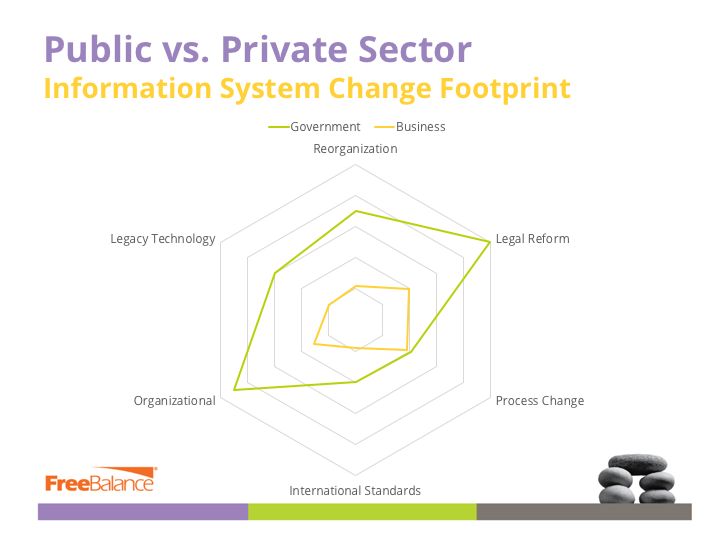
Organizational change management and IT project management complexity in government includes:
- Politics – impact of political concerns adds complexity, politicians want to look good
- The GRP Success Blueprint tracks governance, stability, and social-cultural enablers
- Lines of Business – governments operate far more “lines of business” than conglomerates, have far more diverse requirements
- The GRP Success Blueprint evaluates project scope, and whether scope is realistic
- Planning – planning and budgets are guidelines in business, the law in government
- The GRP Success Blueprint leverages Public Expenditure and Financial Accountability (PEFA) assessments to determine planning capabilities
- Performance Management – businesses have an objective bottom-line: profit (or loss), whereas governments
- The GRP Success Blueprint examines program and performance budgeting maturity, and the integration of financial systems with government goals
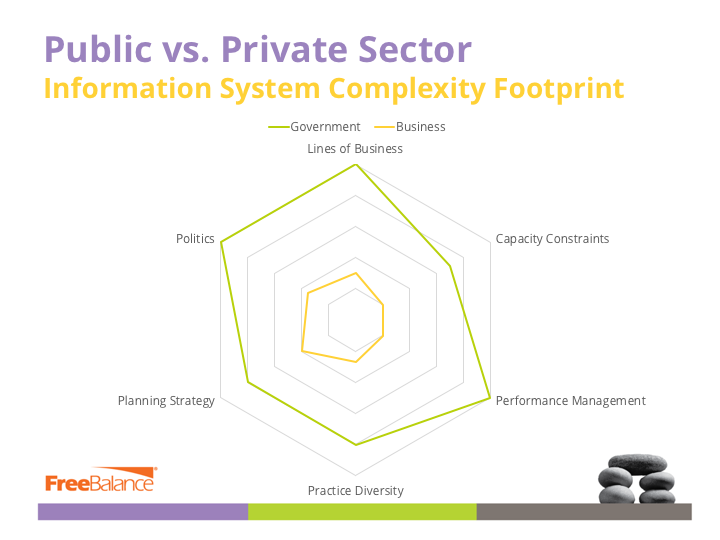
Other challenging characteristics of government IT include:
- Yearly budgets: Although governments plan across many years, the fiscal focus is always on the yearly budget. This creates more short-term thinking of saving money within single fiscal years at the expense of long-term returns. This creates increasing technical debt in governments.
- Legacy systems: Short-term thinking often leads to lowering investments in new technology leading to more investment in “keeping the lights on” and the need for “big bang” projects to yank systems into the modern world.
- Multiple stakeholders: “Due to the complex and inter-connected nature of the government, even small projects have multiple stakeholders across different agencies.” This generates competing incentives and muddles project governance.
- Focus on old processes: Change resistance in government creates situations where new systems are expected to work like legacy systems, even though these old systems have proven ineffective. “So essentially, you end up automating a dumb way of doing things without making any real operational improvements.”
- Lack of business incentives: The nature of public sector employment means that project performance often has little to do with career performance, where “political consideration may play a more salient role when making a decision to start a project or prevent early termination of unsuccessful projects.“
- Devil’s triangle on steroids: Systems integration firms win large turnkey IT projects. Manufacturers or hardware and software products used in the project are rarely part of the governance structure. This creates an environment where systems integrators have incentives to improve revenue through scope increases and manufacturers begin the view integrators as main customers. Time and material “projects will almost always be over budget and off schedule as contractors have clear incentives to bill the government as much they can.”
The Good News
Your government can manage GRP and large IT project risk.
How to become a beta GRP Success Blueprint User
- Leave a comment to this blog entry with an e-mail address
- Indicate whether you want the comment to be made public or not
- We will get in touch with you
